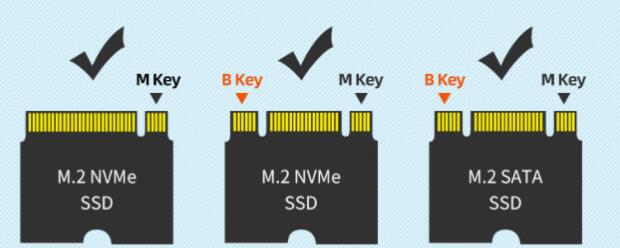Home > News > Industry News
The two commonly used interfaces for solid-state drives at present (the shape of the interface connected to the motherboard) are SATA3 and M.2.

(1) Solid state drives using SATA3 interface (currently the interface method used by mechanical hard drives) have the same transmission method as SATA3 mechanical hard drives, and the speed improvement relies entirely on the storage and reading speed of solid-state drives, which are faster than mechanical hard drives. Approximately 5 times that of traditional mechanical hard drives.
(2) The introduction of solid-state drives using M.2 interface is as follows:
Size: divided into 2242/2260/2280, with different lengths. The longer the length, the more flash blocks can be placed and the larger the capacity.
Module: The golden finger is divided into B key, also known as Socket2, and M key, also known as Socket3. Different interfaces support different buses.
When matching motherboards, remember to check the types supported by the motherboard. Currently, most of them are M key modules.
Bus mode: divided into SATA3 and PCI-E.
A. Solid state drives that use SATA3 mode and SATA3 interface are similar in speed and belong to the slowest among solid-state drives.
B. The PCI-E bus solid-state drive is used instead of the PCI-E interface on desktop computers. Currently, the PCI-E interface is represented as PCI-E 3 × 4, also known as express Gen 3 × 4. The bus width is 32Gbps, and the actual transfer rate exceeds 1000 MB/s
Protocol: SSDs using PCI-E cables usually come with NVMe, which is actually a logical device interface standard like AHCI. NVMe, also known as Non Volatile Memory Standard in Chinese, is a specification for SSDs that use PCI-E channels. The advantages of NVMe lie in lower latency, higher transmission rate, and lower power consumption control. Using M.2 interface to support PCI-E3 × 4 SSD, the speed can reach 1000 MB/s. If NVMe protocol is supported, the speed will exceed 2000 M/s
SSDs that support NVMe protocol must support PCI-E3 × 4, but SSDs that support PCI-E3 × 4 may not necessarily support NVMe protocol.
Embedded motherboard is generally understood as the CPU board embedded in the device for contro...
Both industrial control computers and computers belong to the category of computers, and their m...
X86 embedded motherboard is a type of embedded motherboard, characterized by its small size and...
Shenzhen VKoming Technology CO.,Ltd.
Phone: 13612966567
Tel: 0755-28196692
Email: lyp@micipc.com
Address: 508, Building 8, Evergrande Fashion Valley Building, Fulong Road, Henglang Community, Dalang Street, Longhua District, Shenzhen City